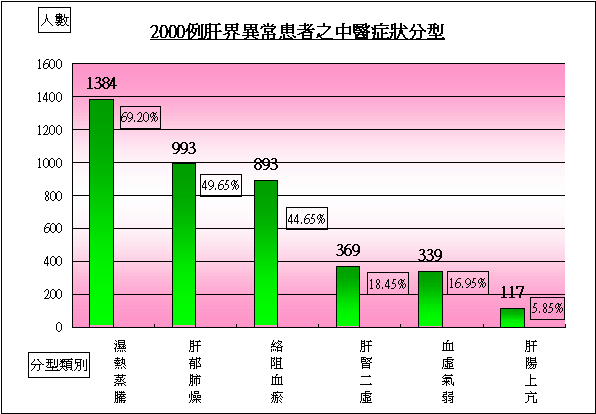Viewpoint of TCM on hepatophilic virus diseases
Traditional Chinese medicine (TCM) considers that disease pathogenesis is the struggle between causative factors of disease and the body’s healthy energy. This is present throughout the entire disease process, developing vertically can giving decisive influence to evolutionary changes of disease. Clinical symptoms are always changing; they only reflect a certain stage of the disease suffering and are cross sections of the vertical disease process at that particular time. The change of symptoms is controlled by pathogenesis of the disease and therefore, only on the basis of understanding the pathogenesis, that the symptoms as well as the whole disease entity could be better recognized. For similar reasons, treatment could be undertaken accordingly with regard to the body as a whole and also to the prognosis of the disease.
According to our comprehension from clinical practice, pestilential evil such as hepatophilic virus may be trapped inside the body; if there is no TCM to soothe and carry it out, it will gradually develop “from the exterior to the interior, and from shallow to deep layer”. The pathology, pathogenesis and development of illness of chronic hepatitis are a good example to demonstrate “the correctness of the concept of the organism as a whole”, which for thousands of years, was the recognition of disease by traditional Chinese medicine.” It is indeed appropriate to explain the course of development of chronic hepatitis, the different symptoms appearing in different stages of chronic hepatitis and the characteristic simultaneous injuries of multiple organs caused by hepatitis virus invasion, by the traditional Chinese medicine principles of “concept of the organism as a whole” and “treatment according to overall analysis of syndrome differentiation.”
Traditional Chinese medicine considers when the pestilential evil invades the body. There is retention of wetness-heat and hiding in ambush of pestilential toxicity internally. At first, it accumulates at the middle-energizer (middle portion of the body cavity) housing the spleen and stomach and vaporizes to reach the liver and gall bladder. When the liver-energy can not be disseminated, it becomes stagnant in the liver and causes motional dysfunction of the spleen and stomach. Consequently, the accumulation changes to heat, the liver fire flares up and causes dryness of the lung and abundance of heart fire, leading to emotional instability, weakness of energy and stasis of blood.
Furthermore, the liver fire may descend to the urinary bladder, forming wetness-heat of the lower-energizer (lower portion of the body cavity) which generates wetness-turbidity in the interior, causing gonorrhea, leucorrhoea and difficulty in urination and defecation. Therefore, the uterus becomes dry and congested, the blood turns from stasis to abnormal activation and finally hemorrhage occurs. The patient may suffer from menstrual disorders or uterine coldness causing infertility. Different disease occur at different stages of life and oftentimes, as the age of the patient increases and as time goes by, the wetness-heat evil stays long in the body and becomes difficult to be eliminated. Therefore, from the patient’s detailed past history and physical signs, one may usually find traces of injury in the body caused by hepatophilic virus.
The above discussion gives elucidation to the “concept of the organism as a whole” of traditional Chinese medicine, and this theory guides correct understanding of the nature of diseases clinically. We may take a look at the TCM classification of virus hepatitis; it includes six forms, namely:
(1) The liver-energy stagnation and lung dryness form;
(2) Wetness-heat evaporation form;
(3) Weakness of energy and blood deficiency form;
(4) Channel blockage and stasis of blood form;
(5) Abnormal rise of liver-yang form
(including the three results produced by this form – yin weakness of liver and kidney, weakness of yin and exuberance of yang and weakness of yin and yang); and
(6) Weakness of liver and kidney.
These six forms show the entire clinical response of “from shallow to deep layer, from the exterior to the interior” after infection of the body by hepatophilic virus. But this kind of classification is in fact artificial and is done only for facilitation in describing the disease. In actual practice, the patient in different stages of disease may present different symptoms or symptoms ascribable to two or more forms of the disease. There are actually no margin between the forms; but, on the other hand, in the course of treatment, “treating the fundamental” is the absolute principle in all forms.
The following figure is drawn according to the past history and present symptoms of 2000 patients of abnormal liver margin which we treated in Hong Kong. According to traditional Chinese medicine classification, the figure shows nearly 70% of the hepatophilic virus hepatitis patients present the “wetness-heat evaporation form” manifestations and nearly 50% of the patients had the liver-energy stagnation and lung dryness form” clinical symptoms.
Figure 1–TCM symptom classification of 2000 cases of abnormal liver margin

By WONG Kwok Hung
3rd October 2000
(Translated by Professor ZHENG Hua En, May 2001)
